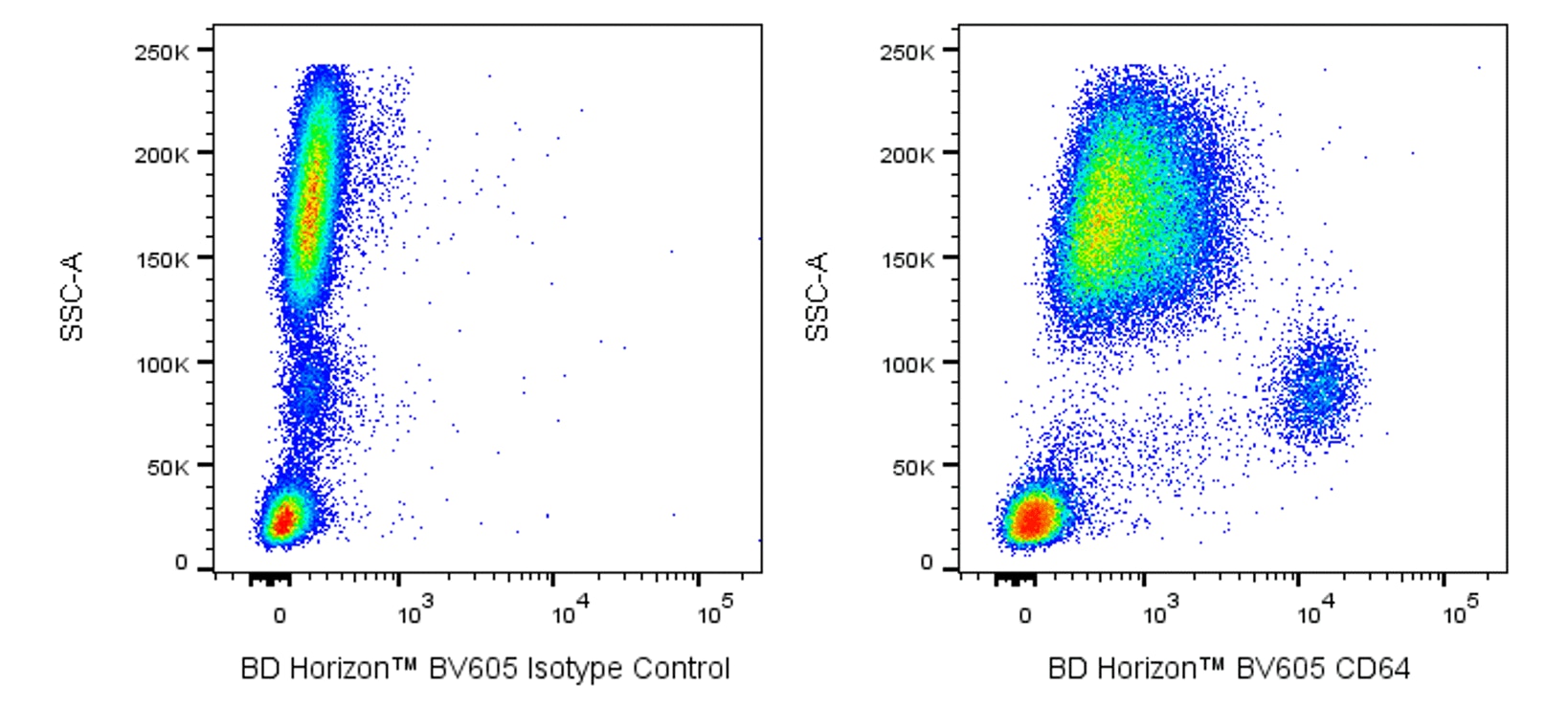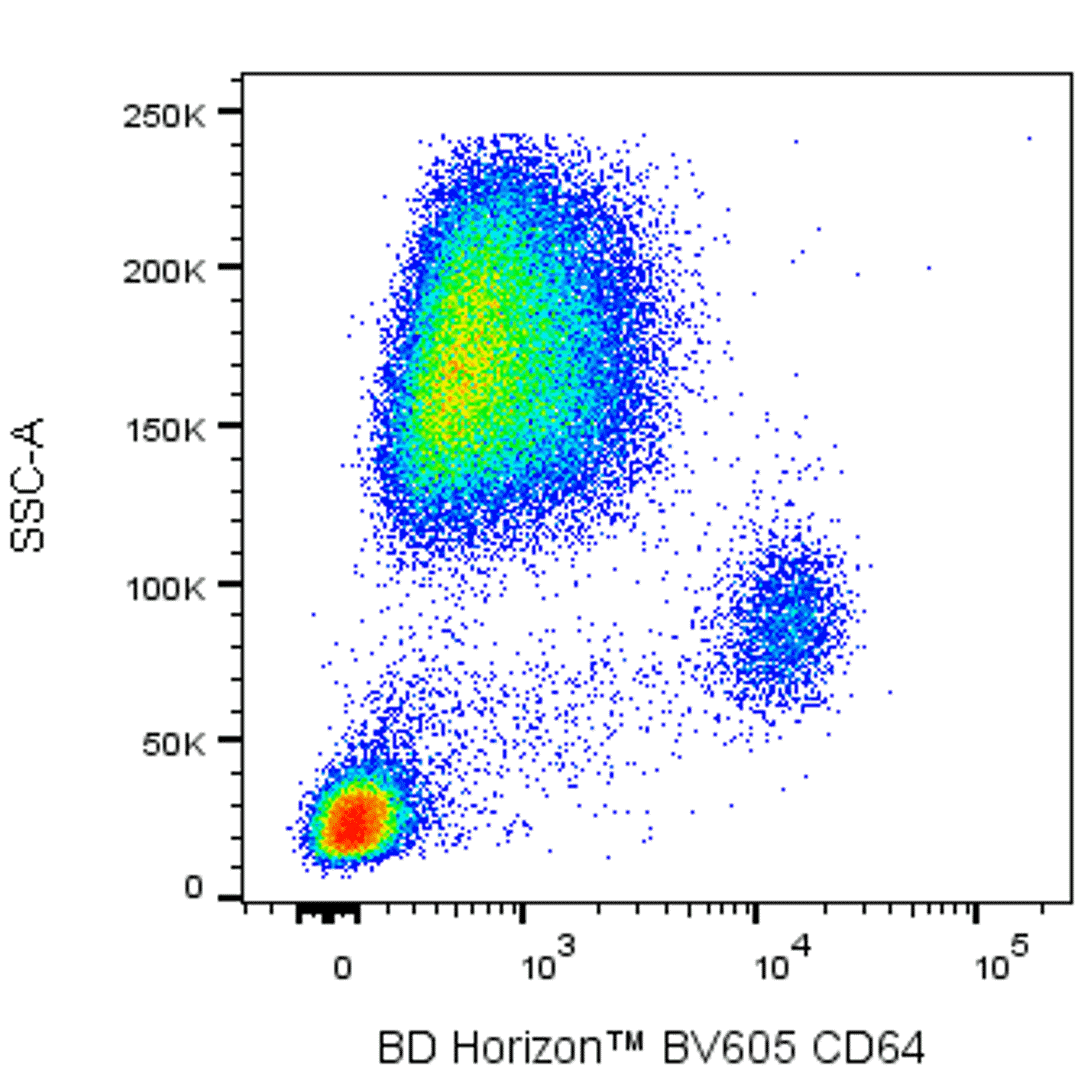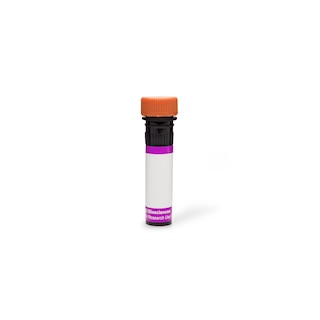-
Training
- Flow Cytometry Basic Training
-
Product-Based Training
- BD Accuri™ C6 Plus Cell Analyzer
- BD FACSAria™ Cell Sorter Cell Sorter
- BD FACSCanto™ Cell Analyzer
- BD FACSDiscover™ A8 Cell Analyzer
- BD FACSDiscover™ S8 Cell Sorter
- BD FACSDuet™ Sample Preparation System
- BD FACSLyric™ Cell Analyzer
- BD FACSMelody™ Cell Sorter
- BD FACSymphony™ Cell Analyzer
- BD LSRFortessa™ Cell Analyzer
- Advanced Training
Old Browser
This page has been recently translated and is available in French now.
Looks like you're visiting us from {countryName}.
Would you like to stay on the current location site or be switched to your location?
BD Horizon™ BV605 Mouse Anti-Human CD64
Clone 10.1 (RUO)

Multiparameter flow cytometric analysis of CD64 expression on Human peripheral blood leucocytes. Human whole blood was stained with either BD Horizon™ BV605 Mouse IgG1 Isotype Control (Cat. No. 562652; Left Plot) or BD Horizon™ BV605 Mouse Anti-Human CD64 antibody (Cat. No. 569172; Right Plot) at 1 µg/test. Erythrocytes were lysed with BD FACS Lysing Solution (Cat. No. 349202). The bivariate pseudocolor density plot showing the correlated expression of CD64 (or Ig Isotype control staining) versus side light-scatter (SSC-A) signals was derived from gated events with the forward and side light-scatter characteristics of intact leucocyte populations. Flow cytometric analysis was performed using a BD FACSymphony™ Cell Analyzer System and FlowJo™ software.

Multiparameter flow cytometric analysis of CD64 expression on Human peripheral blood leucocytes. Human whole blood was stained with either BD Horizon™ BV605 Mouse IgG1 Isotype Control (Cat. No. 562652; Left Plot) or BD Horizon™ BV605 Mouse Anti-Human CD64 antibody (Cat. No. 569172; Right Plot) at 1 µg/test. Erythrocytes were lysed with BD FACS Lysing Solution (Cat. No. 349202). The bivariate pseudocolor density plot showing the correlated expression of CD64 (or Ig Isotype control staining) versus side light-scatter (SSC-A) signals was derived from gated events with the forward and side light-scatter characteristics of intact leucocyte populations. Flow cytometric analysis was performed using a BD FACSymphony™ Cell Analyzer System and FlowJo™ software.



Multiparameter flow cytometric analysis of CD64 expression on Human peripheral blood leucocytes. Human whole blood was stained with either BD Horizon™ BV605 Mouse IgG1 Isotype Control (Cat. No. 562652; Left Plot) or BD Horizon™ BV605 Mouse Anti-Human CD64 antibody (Cat. No. 569172; Right Plot) at 1 µg/test. Erythrocytes were lysed with BD FACS Lysing Solution (Cat. No. 349202). The bivariate pseudocolor density plot showing the correlated expression of CD64 (or Ig Isotype control staining) versus side light-scatter (SSC-A) signals was derived from gated events with the forward and side light-scatter characteristics of intact leucocyte populations. Flow cytometric analysis was performed using a BD FACSymphony™ Cell Analyzer System and FlowJo™ software.
Multiparameter flow cytometric analysis of CD64 expression on Human peripheral blood leucocytes. Human whole blood was stained with either BD Horizon™ BV605 Mouse IgG1 Isotype Control (Cat. No. 562652; Left Plot) or BD Horizon™ BV605 Mouse Anti-Human CD64 antibody (Cat. No. 569172; Right Plot) at 1 µg/test. Erythrocytes were lysed with BD FACS Lysing Solution (Cat. No. 349202). The bivariate pseudocolor density plot showing the correlated expression of CD64 (or Ig Isotype control staining) versus side light-scatter (SSC-A) signals was derived from gated events with the forward and side light-scatter characteristics of intact leucocyte populations. Flow cytometric analysis was performed using a BD FACSymphony™ Cell Analyzer System and FlowJo™ software.

Multiparameter flow cytometric analysis of CD64 expression on Human peripheral blood leucocytes. Human whole blood was stained with either BD Horizon™ BV605 Mouse IgG1 Isotype Control (Cat. No. 562652; Left Plot) or BD Horizon™ BV605 Mouse Anti-Human CD64 antibody (Cat. No. 569172; Right Plot) at 1 µg/test. Erythrocytes were lysed with BD FACS Lysing Solution (Cat. No. 349202). The bivariate pseudocolor density plot showing the correlated expression of CD64 (or Ig Isotype control staining) versus side light-scatter (SSC-A) signals was derived from gated events with the forward and side light-scatter characteristics of intact leucocyte populations. Flow cytometric analysis was performed using a BD FACSymphony™ Cell Analyzer System and FlowJo™ software.

Multiparameter flow cytometric analysis of CD64 expression on Human peripheral blood leucocytes. Human whole blood was stained with either BD Horizon™ BV605 Mouse IgG1 Isotype Control (Cat. No. 562652; Left Plot) or BD Horizon™ BV605 Mouse Anti-Human CD64 antibody (Cat. No. 569172; Right Plot) at 1 µg/test. Erythrocytes were lysed with BD FACS Lysing Solution (Cat. No. 349202). The bivariate pseudocolor density plot showing the correlated expression of CD64 (or Ig Isotype control staining) versus side light-scatter (SSC-A) signals was derived from gated events with the forward and side light-scatter characteristics of intact leucocyte populations. Flow cytometric analysis was performed using a BD FACSymphony™ Cell Analyzer System and FlowJo™ software.




Regulatory Status Legend
Any use of products other than the permitted use without the express written authorization of Becton, Dickinson and Company is strictly prohibited.
Preparation And Storage
Recommended Assay Procedures
BD® CompBeads can be used as surrogates to assess fluorescence spillover (compensation). When fluorochrome conjugated antibodies are bound to BD® CompBeads, they have spectral properties very similar to cells. However, for some fluorochromes there can be small differences in spectral emissions compared to cells, resulting in spillover values that differ when compared to biological controls. It is strongly recommended that when using a reagent for the first time, users compare the spillover on cells and BD® CompBeads to ensure that BD® CompBeads are appropriate for your specific cellular application.
For optimal and reproducible results, BD Horizon Brilliant™ Stain Buffer should be used anytime BD Horizon Brilliant dyes are used in a multicolor flow cytometry panel. Fluorescent dye interactions may cause staining artifacts which may affect data interpretation. The BD Horizon Brilliant Stain Buffer was designed to minimize these interactions. When BD Horizon Brilliant Stain Buffer is used in in the multicolor panel, it should also be used in the corresponding compensation controls for all dyes to achieve the most accurate compensation. For the most accurate compensation, compensation controls created with either cells or beads should be exposed to BD Horizon Brilliant Stain Buffer for the same length of time as the corresponding multicolor panel. More information can be found in the Technical Data Sheet of the BD Horizon Brilliant Stain Buffer (Cat. No. 563794/566349) or the BD Horizon Brilliant Stain Buffer Plus (Cat. No. 566385).
Product Notices
- Please refer to www.bdbiosciences.com/us/s/resources for technical protocols.
- Please observe the following precautions: Absorption of visible light can significantly alter the energy transfer occurring in any tandem fluorochrome conjugate; therefore, we recommend that special precautions be taken (such as wrapping vials, tubes, or racks in aluminum foil) to prevent exposure of conjugated reagents, including cells stained with those reagents, to room illumination.
- Caution: Sodium azide yields highly toxic hydrazoic acid under acidic conditions. Dilute azide compounds in running water before discarding to avoid accumulation of potentially explosive deposits in plumbing.
- Since applications vary, each investigator should titrate the reagent to obtain optimal results.
- For fluorochrome spectra and suitable instrument settings, please refer to our Multicolor Flow Cytometry web page at www.bdbiosciences.com/colors.
- An isotype control should be used at the same concentration as the antibody of interest.
- CF™ is a trademark of Biotium, Inc.
- Although every effort is made to minimize the lot-to-lot variation in the efficiency of the fluorochrome energy transfer, differences in the residual emission from BD Horizon™ BV421 may be observed. Therefore, we recommend that individual compensation controls be performed for every BD Horizon™ BV605 conjugate.
- BD Horizon Brilliant Violet 605 is covered by one or more of the following US patents: 8,110,673; 8,158,444; 8,227,187; 8,455,613; 8,575,303; 8,354,239.
- BD Horizon Brilliant Stain Buffer is covered by one or more of the following US patents: 8,110,673; 8,158,444; 8,575,303; 8,354,239.
- Please refer to http://regdocs.bd.com to access safety data sheets (SDS).
- Human donor specific background has been observed in relation to the presence of anti-polyethylene glycol (PEG) antibodies, developed as a result of certain vaccines containing PEG, including some COVID-19 vaccines. We recommend use of BD Horizon Brilliant™ Stain Buffer in your experiments to help mitigate potential background. For more information visit https://www.bdbiosciences.com/en-us/support/product-notices.
- For U.S. patents that may apply, see bd.com/patents.
Companion Products






The 10.1 monoclonal antibody specifically binds to CD64, a 72 kDa type I transmembrane glycoprotein that is a high affinity receptor for human IgG (FcγRI), especially the IgG1 and IgG3 subclasses. CD64 is expressed on monocytes, macrophages, dendritic cells, granulocytes activated with interferon-gamma and early myeloid lineage cells. CD64 associates with a signaling FcRγ homodimer to form the functional high affinity FcγRI complex. CD64 functions in both innate and adaptive immune responses and mediates endocytosis, phagocytosis, antigen presentation, antibody-dependent cellular toxicity, cytokine release and superoxide generation.

Development References (5)
-
CD64. In: Zola H. Leukocyte and stromal cell molecules : the CD markers. Hoboken, N.J.: Wiley-Liss; 2007:151.
-
Dougherty GJ, Selvendran Y, Murdoch S, Palmer DG, Hogg N. The human mononuclear phagocyte high-affinity Fc receptor, FcRI, defined by a monoclonal antibody, 10.1. Eur J Immunol. 1987; 17(10):1453-1459. (Immunogen: Blocking, Flow cytometry, Inhibition). View Reference
-
Indik ZK, Hunter S, Huang MM, et al. The high affinity Fc gamma receptor (CD64) induces phagocytosis in the absence of its cytoplasmic domain: the gamma subunit of Fc gamma RIIIA imparts phagocytic function to Fc gamma RI. Exp Hematol. 1994; 22(7):599-606. (Biology). View Reference
-
Sun W, O'Shea JJ, Guyre PM. CD64 Workshop Panel Report. In: Kishimoto T. Tadamitsu Kishimoto .. et al., ed. Leucocyte typing VI : white cell differentiation antigens : proceedings of the sixth international workshop and conference held in Kobe, Japan, 10-14 November 1996. New York: Garland Pub.; 1997:988-990.
-
van Vugt MJ, Heijnen AF, Capel PJ, et al. FcR gamma-chain is essential for both surface expression and function of human Fc gamma RI (CD64) in vivo. Blood. 1996; 87(9):3593-3599. (Biology). View Reference
Please refer to Support Documents for Quality Certificates
Global - Refer to manufacturer's instructions for use and related User Manuals and Technical data sheets before using this products as described
Comparisons, where applicable, are made against older BD Technology, manual methods or are general performance claims. Comparisons are not made against non-BD technologies, unless otherwise noted.
For Research Use Only. Not for use in diagnostic or therapeutic procedures.